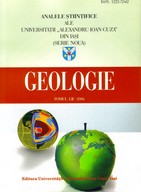
English title
- SERIA
GEOLOGIE (AUI-G) - |

|
| Log in New account |
| Home | Main Page | Guide for Authors | Peer Review | New Articles | Events | Archive | Index | Contact us |

|
Article Zinc in the flotation tailings pond of Brăteasa Valley (Suceava County, Romania)
Dan Stumbea - “Alexandru Ioan Cuza” University of Iaşi, Department of Geology, 20A Carol I Blv, 700505 Iaşi, Romania, Department of Geology View abstract as pdf file | View full article as pdf file Abstract: The tailings pond located in Brăteasa Valley, near the former ore-processing plant of Tarnița, shows a particular shape of the beach, given the tailings stockpiles deposited on its northwestern sector. This geometry produced three types of waste: (i) tailings of the stockpiles (A-type); (ii) tailings from the lowlands (B-type), laying underneath the salt crusts; (iii) salt crusts, precipitated from the water puddles accumulated on the beach lowlands. Pyrite oxidation controls the pH of the three environments, so that the pyrite-poor B- and C-type wastes have a little higher pH (above 2.5) than type A. Descriptive statistics revealed that the distribution of Zn in the three types of waste is related to the following minerals: (i) sphalerite (in A-type waste); (ii) sphalerite and secondary minerals, i.e., jarosite, goethite, and ferrihydrite (in B-type waste); (iii) secondary minerals, i.e., rozenite, halotrichite, and kaolinite (in C-type waste). Zn-bearing secondary minerals that may trap Zn in their structure seems to appear at a pH higher than 2.5. The Principal Component Analysis (PCA) confirmed the influence of the nature of minerals (either primary or secondary) on the Zn distribution in the waste. It also showed that the amplitude of water evaporation from either tailings pores or shallows puddles accumulated on the lowlands would play a role in the Zn distribution. Keywords: zinc, secondary minerals, descriptive statistics, PCA, tailings, Eastern Carpathians |
copyright © 2024 Department of Geology |